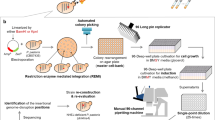Summary
Through the course of five rounds of mutagenesis of a genetically-engineered strain ofAspergillus awamori, the yield of a heterologous protein (the acid protease, calf chymosin) increased four-fold. This was accomplished through the use of an agar plate screen incorporating the colony restrictor 2,6-dichloro-4-nitroaniline (dichloran) and the acid protease inhibitor diazoacetyl-norleucine methyl ester (DAN) to reduce high background concentrations of the native acid protease. A miniaturized liquid culture growth method using 24-well culture plates was an intermediate screen between agar plate and shake flask cultures. Analysis of broth samples for active calf chymosin was accomplished with a highly specific, 96-well microtiter plate turbidimetric assay.
Similar content being viewed by others
References
Ernstrom, C.A. 1974. Milk clotting enzymes and cheese chemistry. In: Fundamental of Dairy Chemistry (Webb, B.H., A.H. Johnson, J.A. Alford, eds.), pp. 662–771 The AVI Publishing Company, Inc., Westport, CT.
Kobayashi, H., I. Kusakabe, S. Yokoyama and K. Murakami. 1985. Substrate specificity of the milk-clotting enzyme fromIrpex lacteus on kappa and beta-casein. Agric. Biol. Chem. 49: 1621–1631.
Kobayashi, H., I. Kusakabe and K. Murakami. 1985. Milkclotting enzyme fromIrpex Lacteus as a calf rennet substitute for cheddar cheese manufacture. Agric. Biol. Chem. 49: 1605–1609.
Zayas, J.F. 1987. Properties and quality characteristics of renning extracted by ultrasound. Biotechnol. Bioeng. 29: 969–975.
Cullen, D., G.L. Gray, L.J. Wilson, K.J. Hayenga M.H. Lamsa, M.W. Rey, S. Norton and R.M. Berka. 1987. Controlled expression and secretion of bovine chymosin inAspergillus nidulans. Bio/tech. 5: 369–376.
Rothe, G.A.L., N.H. Axelsen, P. Johnk and B. Foltmann. 1976. Immunochemical, chromatographic, and milk-clotting, activity measurements for quantification of milk-clotting enzymes in bovine rennets. J. Dairy Res. 43: 85–95.
Koburger, J.A., F.C. Chang and C.I. Wei. 1985. Evaluation of dichloran-rose bengal agar for enumeration of fungi in foods. J. Food Protection 48: 562–563.
Rajagopalan, T.G., W.H. Stein and S. Moore. 1966. The inactivation of pepsin by diazoacetyl-norleucine methyl ester. J. Biol. Chem. 241: 4295–4297.
Tang, J. 1971. Specific and irreversible inactivation of pepsin by substrate-like epoxides. J. Biol. Chem. 246: 4510–4517.
Carlton, B.C., B.J. Brown. 1981. Gene mutation. In: Manual of Methods for General Bacteriology. (Gerhardt, P., ed.), pp. 222–232, American Society for Microbiology, Washington, DC.
Berka, R.M., M. Ward, L.J. Wilson, K.J. Hayenga, K.K. Fong, L.C. Carlomagno and S.A. Thompson. 1989. Molecular characterization and deletion of the aspergillopepsin A gene fromAspergillus awamori. Gene. (Submitted for publication).
Esser, K. and F. Meinhardt. 1986. Genetics of strain improvement in filamentous fungi with respect to biotechnology. In: Overproduction of Microbial Metabolites (Vanek, Z. and Z. Hostalek, eds.), pp. 215–230, Butterworths Inc., Washington, DC.
Rowlands, R.T. 1984. Industrial strain improvement: mutagenesis and random screening procedures. Enzyme Microb. Technol. 6: 3–10.
Nolan, R.D. 1986. Partly automated systems in strain improvement and secondary metabolite detection. In: Overproduction of Microbial Metabolites (Vanek, Z. and Z. Hostalek, eds.), pp. 215–230. Butterworths Inc., Washington, D.C.
Stieglitz, B. and C.P. DeFelice. 1986. Mechanized systems for media dispensing, inoculation and replication of microorganisms. Biotechnol. Bioeng. 28: 1310–1317.
Ward, M. 1989. Chymosin production inAspergillus In: Molecular Industrial Mycology: Systems and Applications. (Leong, S.A. and Berka, R.M., eds.), Marcel Dekker, New York. (In press).
Hayenga, K.J., Crabb, D., Carlomango, L., Arnold, R., Heinsohn, H. and Lawlis, B. 1988. Protein chemistry and recovery of calf chymosin fromAspergillus nidulans andAspergillis awamori. The 18th Linderstrom-Lang Conference: Aspartic Proteinases: Biochemical, physiological and clinical aspects of pepsin, chymosin, renin and related proteinases. Elsinore, Denmark (abstract).
Author information
Authors and Affiliations
Rights and permissions
About this article
Cite this article
Lamsa, M., Bloebaum, P. Mutation and screening to increase chymosin yield in a genetically-engineered strain ofAspergillus awamori . Journal of Industrial Microbiology 5, 229–237 (1990). https://doi.org/10.1007/BF01569680
Received:
Revised:
Accepted:
Issue Date:
DOI: https://doi.org/10.1007/BF01569680




